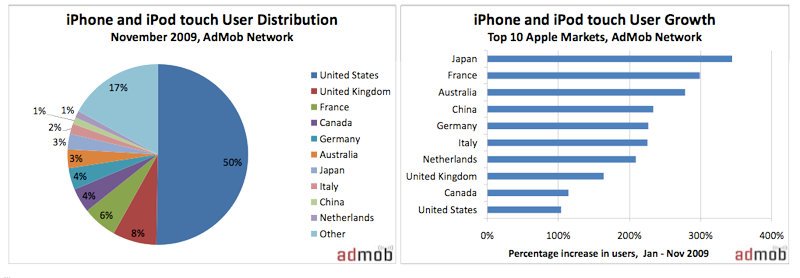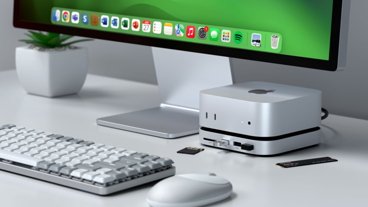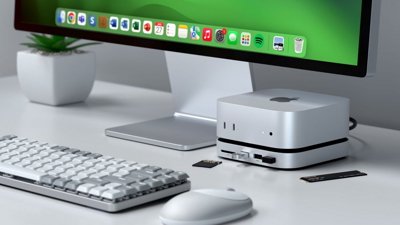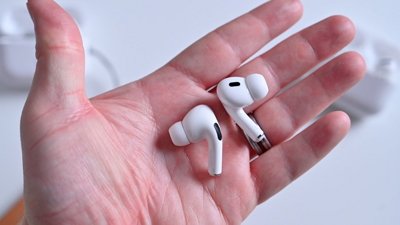According to the latest Mobile Metrics report from AdMob, Canada and the U.S. came in respectively with the ninth and tenth largest increase of iPhone OS users from January to November. In the lead with nearly a 350 percent increase was Japan, followed by France with just under 300 percent. Canada and the U.S. both increased more than 100 percent in 2009.
Still, the U.S. controls a majority of the iPhones that access the AdMob network. In 2009, 50 percent of all global users hailed from America via the iPhone and iPod touch.
AdMob said that there were 18 million iPhones and 7.3 million iPod touches that accessed its network in November. The advertising company was purchased by Google this fall, though Apple officials reportedly met with the company before it was bought out. The nature of the supposed talks between Apple and AdMob are unknown.
The report said that there were 23 countries in the AdMob network with more than 100,000 unique iPhone and iPod touch devices. Apple's handsets saw a 150 percent increase worldwide this year.
"Sales of the iPhone and iPod touch continued to be strong in 2009, and analysts believe that cumulative Apple sales of the two devices could reach 78 million by the end of 2009," the report said.
The report also highlighted traffic growth of the devices running Android mobile operating system, created by AdMob owner Google. The report said that the newly released Motorola Droid represented 22 percent of all Android traffic in November. It was followed by the HTC Magic (21 percent) and HTC Hero (9 percent).
Like the iPhone and iPod touch, Android's greatest presence is in the U.S. A total of 88 percent of all Android traffic originated from America, while the U.K. accounted for 4 percent.
In all, Apple devices accounted for 38.3 percent of the 9.76 million global requests to the AdMob network in November. That represented a 6.2 percent increase over the month prior. Those gains came mostly at the expense of Nokia, which declined 3.3 percent, and Samsung, which lost 1.3 percent.
Smartphones narrowed the gap in November with "feature phones" for requests on the network. As worldwide smartphone shipments increased 24 percent this year, according to Gartner, it is now nearly a 50-50 split between smartphones and feature phones.
 Neil Hughes
Neil Hughes














 Andrew Orr
Andrew Orr
 Christine McKee
Christine McKee
 Sponsored Content
Sponsored Content
 Wesley Hilliard
Wesley Hilliard
 AppleInsider Staff
AppleInsider Staff

 Amber Neely
Amber Neely









13 Comments
Outside of North America? Or outside the United States? It is not the same. North America includes also Mexico, Cuba and Canada, for instance. It is the same as when the word America is used. Americans are all that live in America, which spans from Patagonia to Alaska. Just facts.
Are many iPhones being sold in Cuba?
I don't see any reason to doubt AppleInsider here; if they say North America, then they mean North America. Why are you leaping to conclusions?
Keeps getting better!
My first iPhone this year. For me, the virtual keyboard wins hands-down over a physical one, which in my opinion is a waste of space and hardware. I selected cinema seats for Avatar 3D a few days ago on what amounted to a virtual keyboard, the seating plan and having become used to using one found it a natural process. Arguments against the iPhone seem to keep evaporating. \
I doubt iPhone sales are through the roof in Nicaragua, Haiti, Honduras, and Clipperton Island.
Mexico is the largerst North American market outside the U.S. and Canada, and I doubt whether iPhone sales are skyrocketing there. I'm quite sure what is meant by "North America" is all of "North America."
And on another note:
http://www.wired.com/gadgetlab/2009/02/why-the-iphone/
Oh, having in mind Apple's policies and practices towards customers, I believe, it's time for France to become choosy.